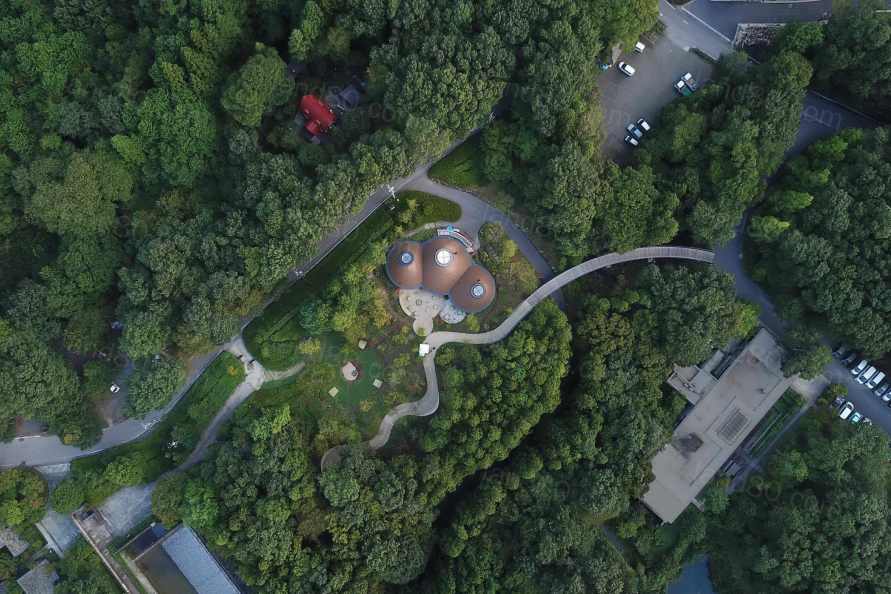那须高原位于枥木县的北部。从东京乘坐新干线不超过75分钟就可以到达以那须山为中心的郁郁葱葱的农耕地区的中心。项目PokoPoko的诞生源于客户希望将现址上的两栋酒店连接起来的愿望,愿景包括对两栋建筑和客房进行扩建和翻新,1986年原有的一座较小的宾馆,后来又增加了一座,使现场的客房总数达到40间。
The Nasu Highlands lay in the northern corner of Tochigi prefecture. It takes no more than 75 minutes by bullet train from Tokyo to the center of this lush farming region which is dominated by Mount Nasu. PokoPoko was born from a client’s wish to connect two hotel buildings on the current site. The vision included an extension and renovation of both buildings and rooms, an original smaller guest house from 1986 and its later addition, bringing the total number of rooms on site to 40.


一座新的人行天桥在场地上形成了一个微妙的联系,两个建筑群之间有一条新的小路蜿蜒在郁郁葱葱的森林中,而就像童话故事中的那样,中途有一片林间空地,有一座现代别墅。项目PokoPoko就像一个标志,从远处看,3个圆锥体从树顶轻快地探出不同的方向。这也是建筑名字的由来,"poko poko "在日语中的意思是 "伸出来 "或 "竖起来"。
A new footbridge forms a subtle link and between the two complexes a new path meanders through the lush forest. And like in a fairy tale, halfway there is a wood clearing with a contemporary cottage: PokoPoko. Like an icon, from afar 3 roof cones poke out lightheartedly in different directions from the top of the trees. And this is where the building get’s it name from as ‘poko poko’ means to stick-out or stick-up in Japanese


新建的PokoPoko项目是一个面向家庭的俱乐部与活动中心,供酒店的客人使用,每个锥体体量都有自己的功能。
The newly built PokoPoko is a family oriented clubhouse and activity centre for the guests of the hotel. Each roof cone has its own function.

中间的圆锥体量可以使用酒店自己种植的新鲜食材进行烹饪活动。各种与食品相关的工作坊让孩子和家长们乐此不疲地制作自己的果酱和腌菜,而一个大的木制烤箱则提供了一个机会,让他们用刚从附近田地里采摘的蔬菜和草药制作自己的披萨。
The middle cone allows for cooking activities based on fresh ingredients grown on the hotel’s own grounds. A variety of food related workshops keeps kids and parents entertained preparing their own jams and pickles, while a big wood-log oven offers an opportunity to make their own pizza with vegetables and herbs just picked from the nearby fields.



在相邻的圆锥体内,一个高大的白色网状结构吸引着孩子们一路向天窗爬去,而较小的孩子则可以在底部的球池中尽情玩耍。当天气不好时,这个室内游乐场也能让孩子们可以自由地释放自己的能量。
Within an adjacent cone a tall white net structure entices the kids to climb all the way up towards the skylight, while smaller kids can delight in a ball pool at the bottom. This indoor playground offers the kids the freedom to release their energy even when the weather gets too gloomy to play outside.



当孩子们疲惫不堪的时候,家长们可以在对面屋顶锥体下的开放式壁炉旁放松。酒店的客人们围坐在火堆旁,在Klein Dytham建筑事务所设计的家具上,拿着自己喜欢的饮料看书,在火焰中凝视,回忆童年的记忆,在森林里露营,在篝火上烤棉花糖。或者只是简单地享受360°的视野,欣赏周围的树木。
While the kids tire themselves out, parents can relax around the open fireplace under the roof cone on the opposite side. The hotel guests sit around the fire, on Klein Dytham architecture’s Dora Dora furniture with their favorite drink, reading a book, gazing in the flames, reminiscing childhood memories of camping in the woods, toasting marshmallows on a bonfire. Or simply enjoying the 360° view to the surrounding trees.


项目PokoPoko既可以是一个热闹的地方,也可以是一个宁静的地方,与外面的森林无缝连接,让人即使在雨天也觉得在大自然中度过了一天。
PokoPoko can be both a lively and a peaceful place, seamlessly connecting to the forest outside, making one feel like having spent a day in nature even on a rainy day.

建筑的屋顶结构由当地松木制成。两根细长的木头构件,间隔开来形成梁,从较低的钢圈梁上升到较小的钢圈,这是屋顶采光的一部分。这些梁用胶合板蒙皮,形成一个有张力的表皮。一层刚性隔热层由木条网格固定,形成一个通风的空腔,再由另一层胶合板剥皮,与纸层一起形成瓦片屋顶的基础。
The roof structure of the building is made from local pine. Two slender timber members with spaced off-cuts form beams, which rise from a lower steel ring beam to a smaller ring which is a part of the roof light. The beams are skinned with plywood sheets to form a tensioned skin. A layer of rigid insulation is held in place by a grid of timber battens, forming a ventilated cavity, which in turn gets skinned by another layer of plywood, which along with a breather paper layer forms the base for the shingle roof.


这个项目立即获得了成功,酒店和会所的需求量很大,因为人们也希望从日本的城市中抽出时间,到乡下去度假,这有利于拉近社会距离。
The project has been an instant success and the hotel and clubhouse have been in demand as people look too to take time out from Japans cities and head to the country side for staycations which are conducive to social distancing.


▽平面图 Plan

▽立面图 Elevation

▽剖面图 Section

Project Name: PokoPoko Club House
Location: Risonare Nasu Hotel, Tochigi Prefecture Japan
Architect: Klein Dytham architecture
Contractor: Tobu Construction
Client: Hoshino Resort
Structutal Engineer: TECTONICA
M & E: Architectural Energy Research
Landscape Designer: Studio TERRA
Lighting Designer: FDS
Photo Credit: Brian Scott Peterson, Mark Dytham, Nacasa & Partners
|